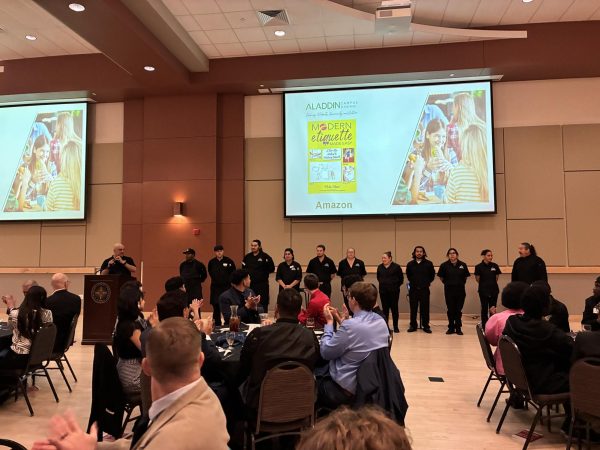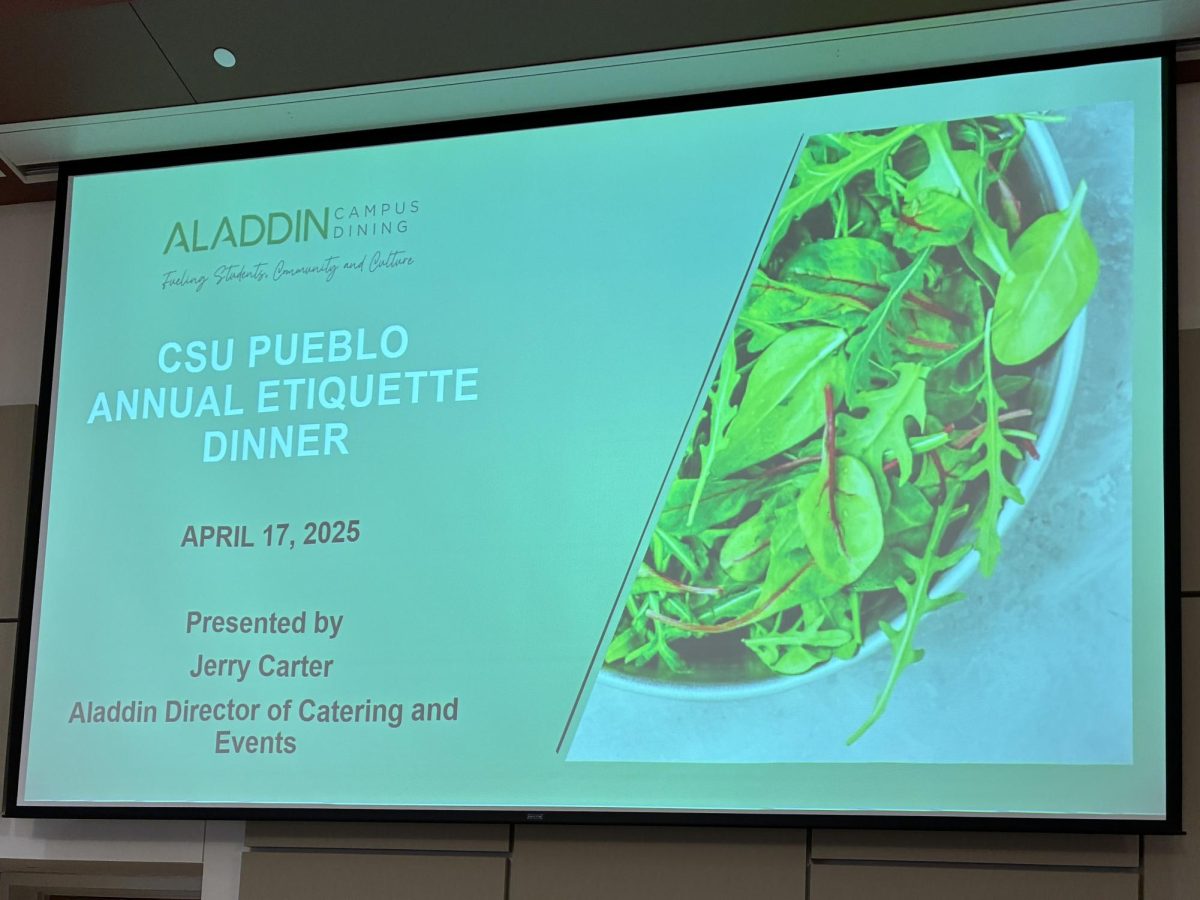
The welcome slide was displayed for the presentation as guests were walking into the ballroom. (Photo by Holly Ward)
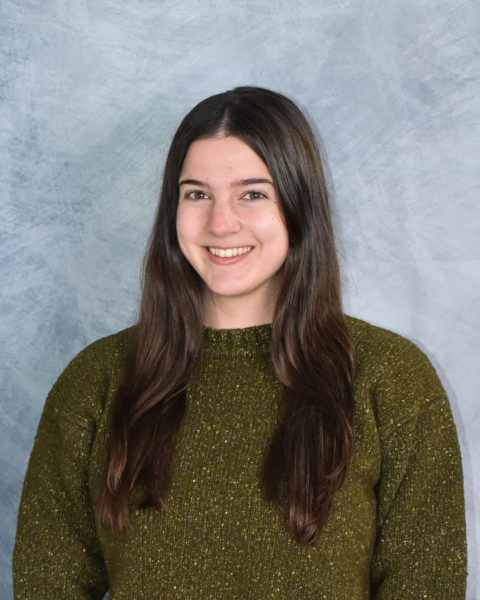
Attending the 25th Annual Etiquette Dinner at Colorado State University Pueblo on April 17 felt a bit like returning to a familiar tradition — but one that still surprises me each time.
Hosted by the Career Center, the event is designed to help students build confidence and professionalism through the often-overlooked art of formal dining etiquette. This was my third time attending, and while I no longer panic at the sight of multiple forks, each year brings new insights, fresh faces, and a renewed appreciation for the details that can make or break a first impression.
Taking place in the Occhiato Student Center Ballroom, this year’s dinner was the first time it offered a five-course meal (normally it is four). It was the largest dinner regarding attendance as well.
“We had 92 students and 25 table leaders,” said Assistant Director of the Career Center, Shantel Frazier, who has overseen the dining etiquette dinner for the past three years.
The Career Center reaches out to staff and faculty as well as other leaders in Pueblo to be leaders for the different tables at the event to aid conversations. Table leaders and students have to RSVP for the event.
“We make sure that the tables are full, and we actually match students’ majors with the table leaders’ backgrounds so they’re able to make those connections,” Frazier said.
Whether it’s for a future interview dinner or simply navigating a formal setting with ease, the experience always leaves me feeling more prepared — and a little more polished.
I attended both my freshman and sophomore year, but I missed last year’s, so it was nice to have a refresher. Every year I have attended, Jerry Carter was leading the way.
Carter is the Aladdin Director of Catering and Events.
“Our goal here tonight is to make sure you’re ready for your next banquet in your life,” Carter said.
The night opened with a taste of dining etiquette history, walking through Medieval Europe, Renaissance and beyond timelines. I found it interesting to learn the difference between American vs. Continental dining rules. There was a slideshow presentation throughout the night that displayed the information Carter was discussing.
“In the American style of eating, after cutting your meat, you switch the fork to your right hand, place your knife on the plate, spear a piece of meat, and then eat it,” the slideshow read.
“In the Continental eating style, you keep your fork in your left hand and convey the food to your mouth after cutting each piece. The knife remains in your hand and may be subtly used to get meat or any other food.”
This was most interesting to learn, since I would say I tend to use more Continental styles of eating in this manner.
We were taught arrival tips, which included always arriving at least 10 minutes early, to wear appropriate attire, to wear strong scents responsibly, and to never chew gum.
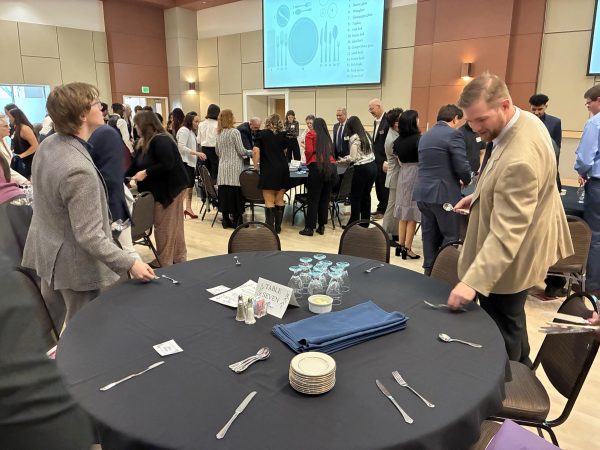
Now it was to the fun part:
In addition to learning how to use the many pieces of silverware and dishware, we were taught how to place the table ourselves.
Everyone got out of their seats and looked at the diagram on the screen to place the silverware, bread and butter plates, and drinking glasses. We also learned how to fold a napkin.
I looked around me to other tables to see how they were doing it to answer my questions on where the dessert spoon should lay (it should lay on the table sideways above where the main dish would go).
The rule of thumb for tackling the many numbers of silverware is to “work your way in.”
As soon as the table was set, we enjoyed bread and butter, poured each other water and tea, and carried on “discussing pleasantries.”
We learned more about the table itself, that “it does not become a storage bin,” according to Carter.
We should never leave our phones on the table, or our purses or wallets. We should stand up to shake hands to arriving guests and we should always acknowledge our host first.
We received our first two courses soon after that. The first being tomato bisque, which we enjoyed using our soup spoons. This was followed by a berry walnut salad with balsamic dressing, which we used our salad forks for.
I thought these were delicious and it appeared that everyone at my table agreed as their plates were empty soon after.
“It’s a fork, not a shovel,” the slideshow read.
“Food should go up to your mouth. You should not go down to your food,” Carter said.
The third course was a scoop of lemon sorbet that was used to cleanse our palettes and it prepared us for our main course. It was amazing!
When it was time for the main course — spinach gouda stuffed chicken, with a cream sauce, rice pilaf and asparagus — the slideshow presentation was complete.
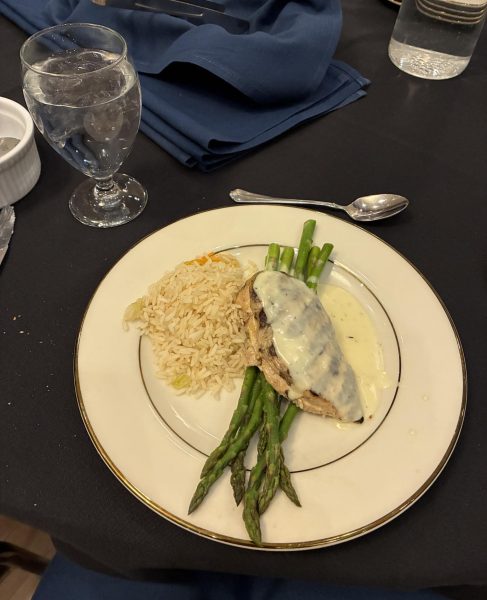
The tables continued to network with their table leaders and peers.
My table (table seven) had two table leaders: David Volk and Alysia Bellamy.
I already knew Volk from my involvement with the Center for Honors and Leadership (as he serves as director).
However, it was my first time meeting Bellamy. She is a psychology adjunct professor at Pueblo Community College. She was so fun to sit next to. Everyone at our table expanded beyond the professional discussions and I got to hear personal stories.
After we finished our fifth course — chocolate mousse cordial with chocolate straw, for dessert — the Career Center set up a photo booth for professional headshots.
The center also gave everyone a folder with a notepad inside, and the book titled “Crucial Conversations: Tools for Talking When Stakes are High.”
Out of all the etiquette dinners I attended, this one was certainly my favorite. The food was great, and the conversations were even better.
I had a chance to speak with Frazier on my way out of the ballroom:
“I’m extremely grateful for my team, my student workers, and to Aladdin. Jerry facilitates the menu. We meet, and it’s customized just for us,” she said.
